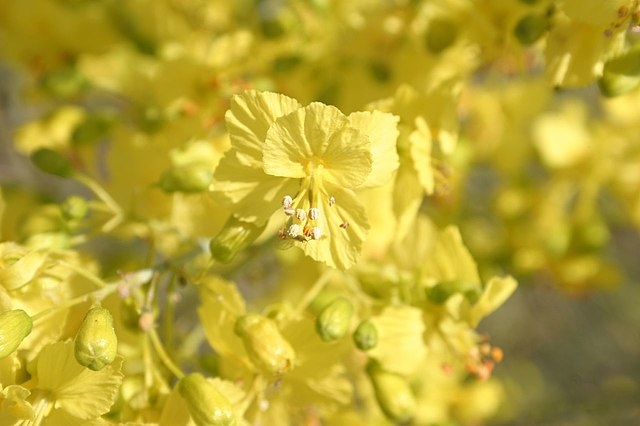Blue Palo Verde
(Parkinsonia florida)
Blue Palo Verde (Parkinsonia florida)
/
/

Joe Decruyenaere
CC BY-SA 2.0
Image By:
Joe Decruyenaere
Recorded By:
Copyright:
CC BY-SA 2.0
Copyright Notice:
Photo by: Joe Decruyenaere | License Type: CC BY-SA 2.0 | License URL: https://creativecommons.org/licenses/by-sa/4.0 | Uploader: File Upload Bot (Magnus Manske) | Publisher: Wikimedia Commons |




























Estimated Native Range
Summary
Parkinsonia florida, commonly known as Blue Palo Verde, is a drought-deciduous large shrub or small tree that typically grows to heights of 10–12 meters (33–39 ft). It is native to the Sonoran and Colorado deserts of the Southwestern USA and Northwestern Mexico, often found in desert washes, flatlands, and hillsides where it forms a critical component of the desert ecosystem. The Blue Palo Verde is notable for its smooth, blue-green bark and branches that photosynthesize, a unique adaptation to its arid environment. During the brief leafing period after rainfall, it produces small, blue-green leaves. The bright yellow, pea-like flowers bloom profusely in late spring, creating a spectacular display that is highly attractive to pollinators such as bees, beetles, and flies. The resulting seed pods are a food source for wildlife, including small rodents and birds.
The Blue Palo Verde is valued for its rapid growth and its ability to provide light, dappled shade, making it an excellent choice for xeriscaping and wildlife gardens in arid climates. It is often used as a focal point in landscapes for its distinctive green-blue silhouette. This species is well-suited to urban planting, border planting, and as a patio tree due to its open form and light shade. It thrives in full sun and requires minimal water once established, preferring well-drained soils. While it is generally low-maintenance, it can be susceptible to root rot if overwatered and may require occasional pruning to maintain a desired shape.CC BY-SA 4.0
The Blue Palo Verde is valued for its rapid growth and its ability to provide light, dappled shade, making it an excellent choice for xeriscaping and wildlife gardens in arid climates. It is often used as a focal point in landscapes for its distinctive green-blue silhouette. This species is well-suited to urban planting, border planting, and as a patio tree due to its open form and light shade. It thrives in full sun and requires minimal water once established, preferring well-drained soils. While it is generally low-maintenance, it can be susceptible to root rot if overwatered and may require occasional pruning to maintain a desired shape.CC BY-SA 4.0
Plant Description
- Plant Type: Tree
- Height: 18-25 feet
- Width: 15-20 feet
- Growth Rate: Moderate
- Flower Color: Yellow
- Flowering Season: Spring
- Leaf Retention: Deciduous
Growth Requirements
- Sun: Full Sun
- Water: Low
- Drainage: Fast, Medium
Common Uses
Bee Garden, Bird Garden, Butterfly Garden, Hummingbird Garden, Low Maintenance, Showy Flowers, Street Planting
Natural Habitat
Native to the Sonoran and Colorado deserts, often found in desert washes, flatlands, and hillsides
Other Names
Common Names:
Scientific Names: Parkinsonia florida , Cercidium floridum
GBIF Accepted Name: Parkinsonia florida (Benth. ex A.Gray) S.Watson